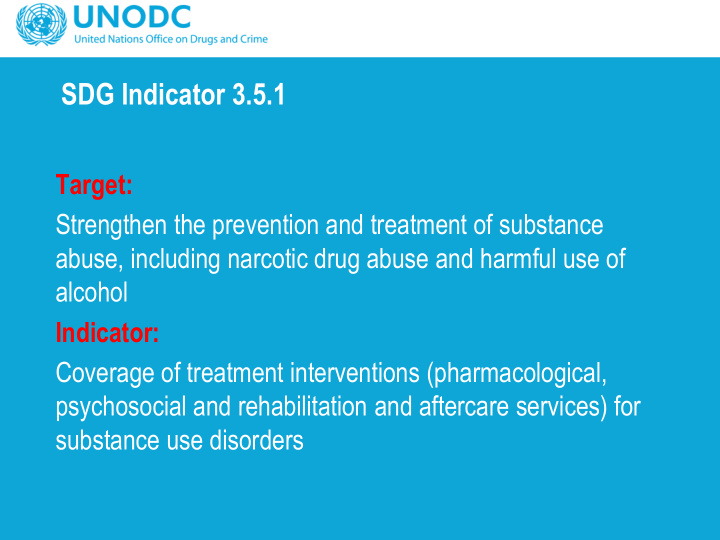



SDG Indicator 3.5.1 Target: Strengthen the prevention and treatment of substance abuse, including narcotic drug abuse and harmful use of alcohol Indicator: Coverage of treatment interventions (pharmacological, psychosocial and rehabilitation and aftercare services) for substance use disorders
Definition and method of computation • population assessed to be in need of treatment interventions -people with drug use or alcohol disorders/dependence ( denominator ) • actual number of the target population receiving different interventions ( numerator ) • The target will be assessed through aggregating the information on the type of treatment interventions and extent of coverage of these for the population in need.
Current reporting Member States currently report to: • UNODC through the Annual Report Questionnaire – Drugs – mandated by the International Drug Conventions – 95 % population coverage (about 100 countries) • WHO (drugs and alcohol) through Quinquennial ATLAS-SU – Drugs and alcohol – 98% population coverage (about 100 countries)
Current reporting • Qualitative indicator on coverage of people with different treatment interventions (low medium and high) - UNODC and WHO – There is also a provision of indicating the estimated number of people in need of treatment (poor reporting) • Quantitative information on number of people treated for drug use disorders by drug type and gender and on number of “problematic drug users” – UNODC
Methodological development • To agree on terminology and definitions • Convert qualitative indicator on coverage of treatment interventions into a quantitative, objective indicator • Support/build capacity of Member States to – estimate the number of people in need of treatment through indirect methods – Number of people provided treatment – treatment reporting systems • Methodology to estimate coverage at regional and global levels (currently UNODC publishes global and regional treatment coverage estimates but not national quantitative estimates)
Processes • The Working Group on treatment coverage established by the WHO TAG on Alcohol and Drug Epidemiology (November 2015) • The process of developing methodology involves several WHO collaborating centers and requires several consensus-based expert decisions. • Definite plan of work on the indicator between WHO, UNODC, UNAIDS and regional agencies and institutions – Will be discussed at the coordinating WHO-UNODC meeting on drug epidemiology data in June 2016. • Testing new approaches for estimating treatment coverage is planned for 2016 through the network of WHO collaborating centers The objective is to produce joint UNODC-WHO-UNAIDS statistics based on multiple data sources
Recommend
More recommend